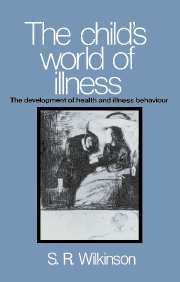Book contents
- Frontmatter
- Contents
- Acknowledgements
- Glossary
- 1 Presenting a problem
- 2 The form of dialogue
- 3 What has gone before: some background information
- 4 The primary structure to the child's world of illness
- 5 Germs and bugs: causal agents
- 6 Dirt and fresh air: the exogenous system
- 7 My castle and the good germs: the endogenous system and its boundary
- 8 ‘Pretend illness’: An analysis of how communication patterns can foster particular forms of complaints
- 9 The consultation: a form of dialogue
- 10 Health education and health promotion
- Appendixes
- References
- Index
9 - The consultation: a form of dialogue
Published online by Cambridge University Press: 23 September 2009
- Frontmatter
- Contents
- Acknowledgements
- Glossary
- 1 Presenting a problem
- 2 The form of dialogue
- 3 What has gone before: some background information
- 4 The primary structure to the child's world of illness
- 5 Germs and bugs: causal agents
- 6 Dirt and fresh air: the exogenous system
- 7 My castle and the good germs: the endogenous system and its boundary
- 8 ‘Pretend illness’: An analysis of how communication patterns can foster particular forms of complaints
- 9 The consultation: a form of dialogue
- 10 Health education and health promotion
- Appendixes
- References
- Index
Summary
‘Do not mistake a child for his symptom’
(Erikson, 1965 p. 59)I started my search with some questions which I felt an observational study could answer. Observations are interpreted from our own peculiar perspectives. Inevitably the questions and suggested answers raised by my review of the child's world of illness will be coloured by my practice as a child psychiatrist. I hope that my analysis of the origins of physical and psychological labels for discomfort which I presented in the preceding chapter will enable the reader to integrate physical and psychological elements in the consultation.
What do these observations of the child's world of illness mean for consultations of all different kinds, be it a child with a parent or parents with a doctor about their child? What is their usefulness and validity in that context? My aim here is to propose some implications for professional consultations based on what I have reported, with limited reference to the relatively meagre literature on consultations with children. Unfortunately there is not yet enough research to comment on validity. The general tenor of research in this field has been to explore the processes going on in a medical consultation around the child, with the assumption that the children are passive attendants. My view is that the consultation setting is like the primary structure which I discussed in chapter 4 – a microsystem with its own properties.
- Type
- Chapter
- Information
- The Child's World of IllnessThe Development of Health and Illness Behaviour, pp. 201 - 236Publisher: Cambridge University PressPrint publication year: 1988



